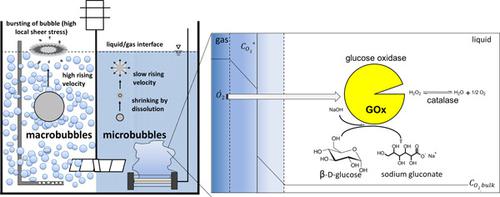当前位置:
X-MOL 学术
›
Biotechnol. Bioeng.
›
论文详情
Our official English website, www.x-mol.net, welcomes your
feedback! (Note: you will need to create a separate account there.)
Comparative Investigation of Fine Bubble and Macrobubble Aeration on Gas Utility and Biotransformation Productivity.
Biotechnology and Bioengineering ( IF 3.5 ) Pub Date : 2020-09-04 , DOI: 10.1002/bit.27556 Benjamin Thomas 1 , Daniel Ohde 1 , Simon Matthes 2 , Claudia Engelmann 1 , Paul Bubenheim 1 , Koichi Terasaka 3 , Michael Schlüter 2 , Andreas Liese 1
Biotechnology and Bioengineering ( IF 3.5 ) Pub Date : 2020-09-04 , DOI: 10.1002/bit.27556 Benjamin Thomas 1 , Daniel Ohde 1 , Simon Matthes 2 , Claudia Engelmann 1 , Paul Bubenheim 1 , Koichi Terasaka 3 , Michael Schlüter 2 , Andreas Liese 1
Affiliation

|
The sufficient provision of oxygen is mandatory for enzymatic oxidations in aqueous solution, however, in process optimization this still is a bottleneck that cannot be overcome with the established methods of macrobubble aeration. Providing higher mass transfer performance through microbubble aerators, inefficient aeration can be overcome or improved. Investigating the mass transport performance in a model protein solution, the microbubble aeration results in higher kLa values related to the applied airstream in comparison with macrobubble aeration. Comparing the aerators at identical kLa of 160 and 60 1/h, the microbubble aeration is resulting in 25 and 44 times enhanced gas utility compared with aeration with macrobubbles. To prove the feasibility of microbubbles in biocatalysis, the productivity of a glucose oxidase catalyzed biotransformation is compared with macrobubble aeration as well as the gas‐saving potential. In contrast to the expectation that the same productivities are achieved at identically applied kLa, microbubble aeration increased the gluconic acid productivity by 32% and resulted in 41.6 times higher oxygen utilization. The observed advantages of microbubble aeration are based on the large volume‐specific interfacial area combined with a prolonged residence time, which results in a high mass transfer performance, less enzyme deactivation by foam formation, and reduced gas consumption. This makes microbubble aerators favorable for application in biocatalysis.
中文翻译:

细泡和大泡曝气对燃气公用事业和生物转化生产力的比较研究。
对于水溶液中的酶促氧化,必须提供足够的氧气,但是,在工艺优化中,这仍然是现有的大泡曝气方法无法克服的瓶颈。通过微泡曝气器提供更高的传质性能,可以克服或改进低效曝气。研究模型蛋白质溶液中的传质性能,与大气泡曝气相比,微泡曝气导致与应用气流相关的更高k L a值。比较相同k L a 下的曝气器160 和 60 1/h,与大气泡曝气相比,微气泡曝气导致气体效用提高了 25 和 44 倍。为了证明微气泡在生物催化中的可行性,将葡萄糖氧化酶催化的生物转化的生产率与大气泡曝气以及节气潜力进行了比较。与在相同应用k L a 下实现相同生产率的预期相反, 微泡曝气使葡萄糖酸生产率提高了 32%,氧气利用率提高了 41.6 倍。观察到的微泡曝气的优点是基于大的体积比界面面积和较长的停留时间,这导致了高传质性能、泡沫形成引起的酶失活较少,并减少了气体消耗。这使得微泡曝气器有利于在生物催化中的应用。
更新日期:2020-09-04
中文翻译:

细泡和大泡曝气对燃气公用事业和生物转化生产力的比较研究。
对于水溶液中的酶促氧化,必须提供足够的氧气,但是,在工艺优化中,这仍然是现有的大泡曝气方法无法克服的瓶颈。通过微泡曝气器提供更高的传质性能,可以克服或改进低效曝气。研究模型蛋白质溶液中的传质性能,与大气泡曝气相比,微泡曝气导致与应用气流相关的更高k L a值。比较相同k L a 下的曝气器160 和 60 1/h,与大气泡曝气相比,微气泡曝气导致气体效用提高了 25 和 44 倍。为了证明微气泡在生物催化中的可行性,将葡萄糖氧化酶催化的生物转化的生产率与大气泡曝气以及节气潜力进行了比较。与在相同应用k L a 下实现相同生产率的预期相反, 微泡曝气使葡萄糖酸生产率提高了 32%,氧气利用率提高了 41.6 倍。观察到的微泡曝气的优点是基于大的体积比界面面积和较长的停留时间,这导致了高传质性能、泡沫形成引起的酶失活较少,并减少了气体消耗。这使得微泡曝气器有利于在生物催化中的应用。











































 京公网安备 11010802027423号
京公网安备 11010802027423号